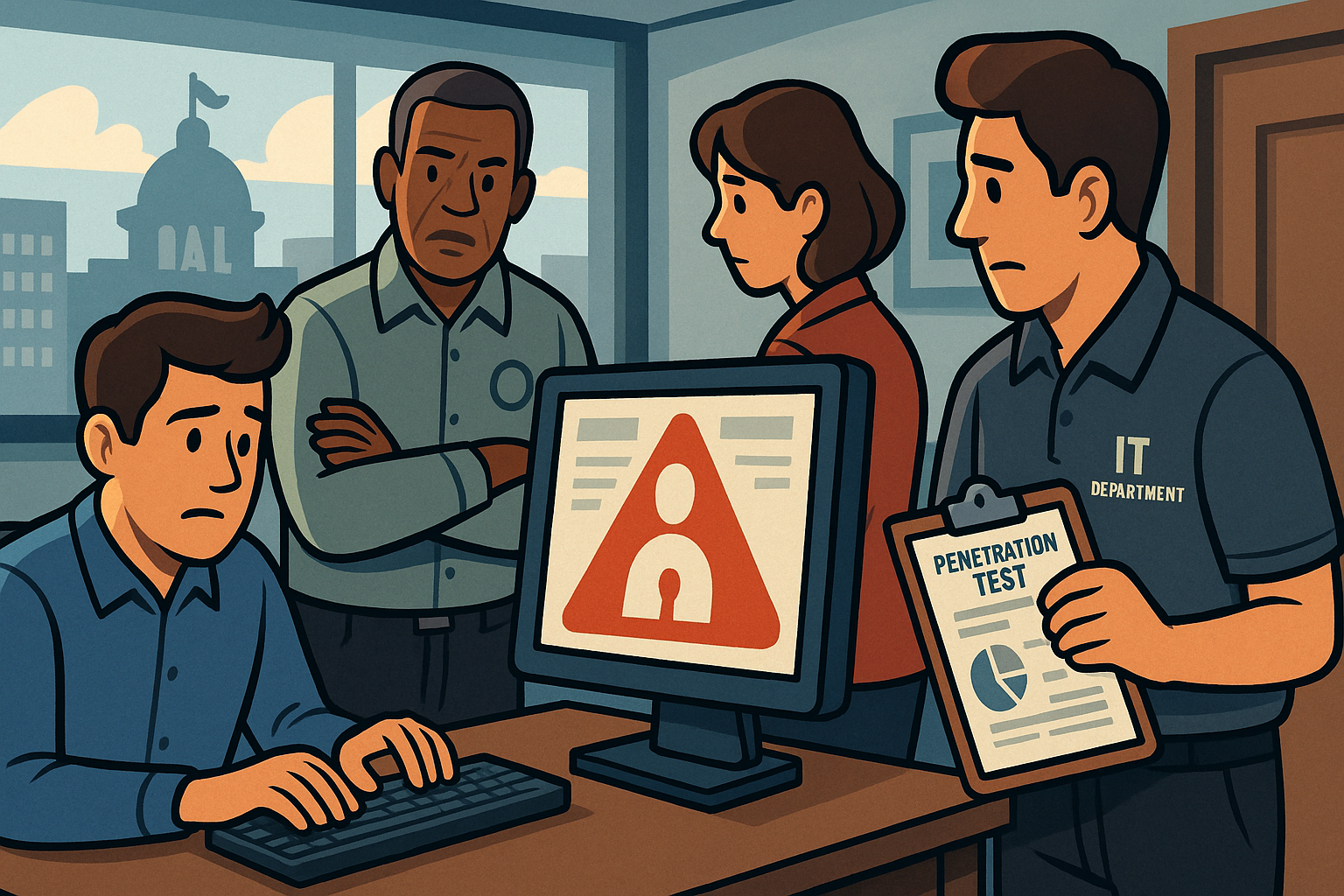Municipal IT Department Discovers Legacy System Weaknesses After Pen-Test Reveals Potential Insider-Threat Pathways
The Challenge
The City of Riverton’s municipal IT department had long been recognized for its reliable delivery of digital services, including utilities, citizen records, and online tax payments. However, over the years, modernization efforts slowed as funding shifted toward public-facing initiatives. Behind the scenes, critical systems quietly aged. Many core applications continued running on software that was more than fifteen years old and had never been subjected to a comprehensive security review.
When the city’s Chief Information Officer commissioned a penetration test in preparation for a future system migration, the findings were alarming. The assessment revealed critical vulnerabilities tied to outdated environments and weak internal access controls. Most concerning was the discovery of several potential insider-threat pathways, Situations in which a trusted employee could access and misuse sensitive resident data without detection.
Legacy systems managing payroll, property tax information, and civic licensing were interconnected through a flat network architecture. Once an attacker gained access to one system, they could easily move laterally across others. Incomplete security logs and limited integration with the city’s centralized monitoring system made detection of such activity nearly impossible. During testing, ethical hackers successfully simulated privilege escalation, demonstrating that an internal user could exfiltrate large data sets containing personally identifiable information such as addresses, payment details, and business registration records.
The implications were significant. Under PIPEDA, unauthorized access, use, or disclosure of personal information, even by an insider, may constitute a privacy breach requiring notification to both affected individuals and the Office of the Privacy Commissioner of Canada. The city also faced reputational risks; any perception that employees could exploit internal systems would undermine public trust.
The IT department faced intense scrutiny from auditors and city council. Questions emerged about how long these weaknesses had existed, whether any data had already been exposed, and why security testing had not been prioritized earlier. Public confidence was already fragile following cyber incidents in other municipalities, and these revelations only deepened concern.
Although there was no evidence of active exploitation, the penetration test exposed broader governance failures: inconsistent patching, outdated access controls, and fragmented oversight between IT and business units. The findings served as a wake-up call that even trusted internal environments could harbor serious risks when technical debt and complacency go unchecked.
The city’s leadership now faced a critical decision, how to modernize its systems without disrupting essential services, and how to restore public confidence in the city’s ability to protect personal information in an evolving threat landscape.
Our Solution
Service Area: Technical Security and Testing, with Privacy and Governance Integration
Our firm was engaged to conduct a focused hardening program tailored for municipal operations governed by PIPEDA and provincial access and privacy laws such as MFIPPA and FOIP.
1. Stabilize and Contain: Implemented a log retention freeze, synchronized system clocks, and applied forensic evidence protocols. We conducted an immediate privileged-access cleanup, enforced multi-factor authentication (MFA), and introduced emergency network segmentation for legacy applications to stop potential lateral movement.
2. Control and Visibility: Integrated legacy servers and applications into a centralized Security Information and Event Management (SIEM) platform, deployed User and Entity Behavior Analytics (UEBA) to baseline employee activity, and implemented Data Loss Prevention (DLP) for large exports. We also introduced Privileged Access Management (PAM) for administrative sessions.
3. Risk-Driven Remediation: Performed Threat and Risk Assessments (TRA) and Privacy Impact Assessments (PIA) for key systems. Where vendor support was no longer available, we applied compensating controls and virtual patching to mitigate exposure.
4. Data Hygiene and Policy: Conducted data mapping to identify and minimize sensitive fields, implemented role-based access controls, and updated information security policies and retention schedules.
5. Assurance Testing: Performed targeted purple-team exercises to confirm remediation effectiveness and validate that all previously identified attack paths were fully mitigated.
The Value
- Reduced Insider Risk: Standing privileged accounts decreased by approximately 70%, with all remaining elevated sessions brokered and recorded through PAM.
- Enhanced Visibility: Over 95% of legacy systems now generate standardized logs integrated into the SIEM. Alerts are configured to flag anomalous access patterns and bulk data exports.
- Improved Network Resilience: East–west network restrictions reduced cross-system exposure by 80%, validated through follow-up testing.
- Regulatory Compliance: Documented TRAs and PIAs demonstrate alignment with PIPEDA’s safeguard principles and provincial privacy obligations, supporting future audit readiness.
- Operational Efficiency: The city’s average detection time for suspicious insider behavior decreased from several weeks to under 24 hours. The average response time to high-severity access alerts fell below four hours.
- Continuity and Stability: The city maintained uninterrupted service delivery during remediation, with risk reduction achieved through layered compensating controls.
Implementation Roadmap
Phase 0 – Mobilization (Weeks 0–1)
– Confirmed legal and policy frameworks under PIPEDA and provincial privacy laws.
– Established evidence-handling and system synchronization protocols.
– Conducted immediate privileged-access reviews and enforced MFA.
Phase 1 – Containment and Observation (Weeks 1–4)
– Segmented legacy networks and applied deny-by-default rules.
– Integrated systems with SIEM, UEBA, and DLP solutions.
– Developed and deployed insider-threat monitoring playbooks.
Phase 2 – Assessment and Prioritization (Weeks 3–8)
– Completed TRAs and PIAs for key systems and data flows.
– Ranked vulnerabilities and defined compensating control strategies.
– Updated governance documents and records management policies.
Phase 3 – Remediation and Validation (Weeks 6–14)
– Implemented virtual patching and configuration hardening.
– Applied role-based access controls and data minimization.
– Conducted purple-team exercises to validate containment and control measures.
Phase 4 – Sustainment (Months 3–6)
– Scheduled quarterly access reviews and recurring penetration tests.
– Established performance metrics and dashboards for monitoring risk posture.
– Delivered awareness training for IT, HR, and Records staff on insider threat management and privacy-by-design principles.
– Developed a roadmap for long-term system modernization under new security governance standards.


